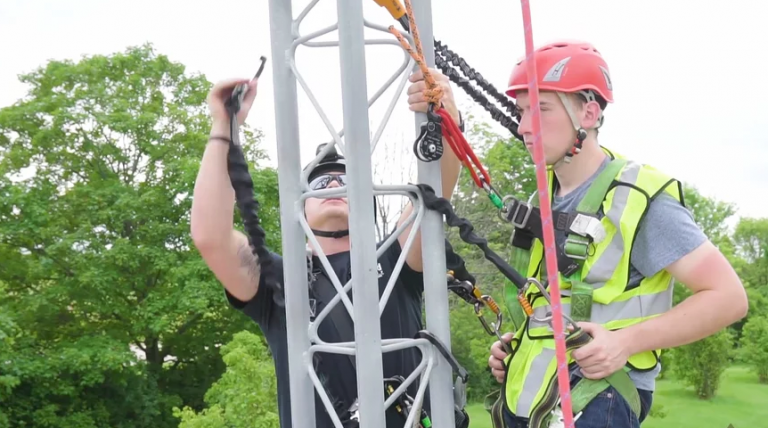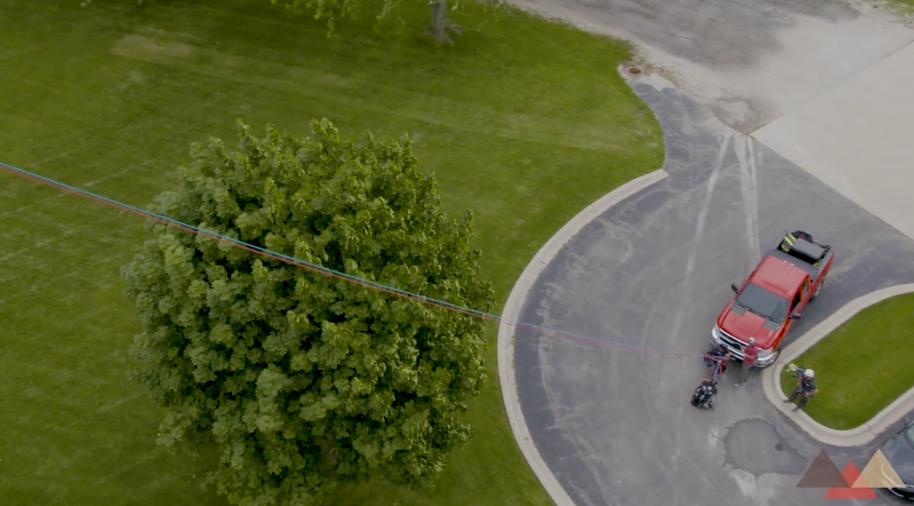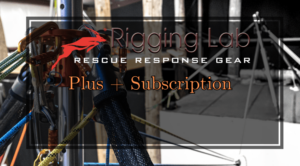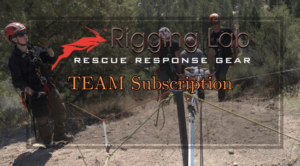Tower Control vs. Ground Control Systems
Tower rescue operations demand precision, teamwork, and the right strategy. Whether employing a Tower Control or Ground Control system, the decision hinges on the specifics of the scenario, including the height of the rescue, team capabilities, and available resources. Both methods have unique advantages and challenges that must be carefully weighed to ensure a safe and efficient operation.
Tower Control Systems
In a Tower Control operation, rescuers ascend the structure with all necessary equipment to manage the rescue from above. This approach requires exceptional training and preparation, as it places significant responsibility on a small team working under demanding conditions.
Key Features of Tower Control:
- Team Selection: Only the most highly trained and physically capable rescuers should undertake tower rescues. Working at heights of 200 feet or more on a vibrating structure requires physical stamina and mental resilience. Climbers must be equipped with food and water to maintain energy levels during the operation.
- Rigging Preparation: Pre-rigging on the ground is essential for keeping the process streamlined and efficient once the team ascends.
- Rescue Scenarios:
- Pick-Off Rescue: Rescuers set static lines above the victim and rappel to perform a direct pick-off.
- Top Lower: A two-rope system is set above the victim, allowing rescuers to secure and lower them to safety.
- Rope Requirements: Rope length must equal or exceed the height of the rescue, with additional slack for contingencies.
Advantages:
- Requires less rope and equipment.
- Enables a smaller, specialized rescue team.
- Faster execution when performed by skilled personnel.
Challenges:
- Concentrates all responsibility on a small team.
- Limited ability to move the victim away from the structure.
- May not accommodate victims with severe trauma effectively.
Tower Control Systems
Tower control involves rescuers ascending the structure with all the necessary equipment to facilitate the rescue from above.
Key Considerations:
- Team Selection: Tower rescues require exceptional physical and mental stamina. Being 200 feet above ground on a vibrating tower leg is not for everyone. Select your two most highly trained, physically capable rescuers. Ensure they are prepared with food and water to sustain energy levels.
- Rigging Techniques: All rigging should be prepped on the ground to keep operations simple and efficient.
- Pick-off Rescue: Rescuers set two static lines above the victim. One rescuer rappels down to perform a standard pick-off rescue.
- Top Lower: Rescuers set up a two-rope system above the victim, connect the patient, and lower them to the ground using top belay systems.
- Rope Length: The rope must at least match the height of the rescue, with extra length for contingencies.
Advantages:
- Requires less rope and equipment.
- Allows for a smaller, highly trained rescue team.
- Operations are faster when executed properly.
Disadvantages:
- Places all responsibility on a small team.
- Limited ability to offset away from the structure.
- May not be suitable for victims with severe trauma.
Ground Control Systems
Ground Control operations rely on fixed brakes and progress capture devices managed primarily from the ground. Climbers still ascend to establish high points, but the bulk of the operation is handled by a larger team on the ground.
Key Features of Ground Control:
- Team Structure: Two skilled climbers ascend to set high point pulleys and prepare the victim for extraction. Ground teams handle the majority of rigging and operational responsibilities.
- Rigging and Equipment: Using methods like bag or bight carries, climbers establish high directional anchors while the ground team manages lowering or hauling systems with devices like the Petzl I’D or CMC MPD.
- Rope Requirements: Typically, 2.5 times the height of the rescue is required to accommodate the rigging system.
Advantages:
- Offers greater flexibility to offset and move the rescue package away from the structure.
- Shares responsibilities among more team members, reducing the burden on individual rescuers.
- Provides ample space for complex rigging setups.
Challenges:
- Requires more rope and specialized equipment.
- Slower operations due to increased complexity.
- Demands a larger team and precise communication to ensure safety and efficiency.
Choosing the Right System
The choice between Tower Control and Ground Control depends on several factors:
- Rescue Height: Tower control is better suited for shorter rescues with minimal offset requirements.
- Available Resources: Ground control requires more equipment and personnel, making it suitable for larger teams.
- Victim Condition: Ground control allows for more flexibility in moving and treating the victim.
- Team Skill Level: Both methods demand skilled rescuers, but tower control places a greater burden on climbers.
By evaluating the scenario and team capabilities, rescue leaders can select the most effective method to ensure a successful and safe outcome.
Peace on your Days,
Lance











15 thoughts on “Tower Rescue: Tower Control Versus Ground Control”
363043 897015 warning Dont any of you individuals ever take me to CiCis pizza! There food looks offensive!|Urban_Elegance| 924888
I got good info from your blog
Hi, I think your site might be having browser compatibility issues. When I look at your website in Safari, it looks fine but when opening in Internet Explorer, it has some overlapping. I just wanted to give you a quick heads up! Other then that, fantastic blog!
Great post. I am facing a couple of these problems.
130914 48135 You should take part in a contest for one of the best blogs on the internet. I will recommend this website! 380433
512599 870304I likewise conceive thus, perfectly written post! . 15970
Appreciate you sharing, great blog post.Really thank you! Will read on…
720924 175932I enjoy your composing style, do carry on creating! I will probably be back! 81866
Hello just wanted to give you a brief heads up and let you know a few of the pictures aren’t loading properly. I’m not sure why but I think its a linking issue. I’ve tried it in two different web browsers and both show the same results.
968810 325664I dont agree with this certain post. However, I did researched in Google and Ive located out that you are correct and I had been thinking inside the incorrect way. Continue producing quality material similar to this. 163027
Sabah dayak yerdim. ıslanmasın diye üzerine geçirdiğim mavi
naylon ıslak çorap ve eldivenlerimizi kömür sobasında kurutur.
Yay google is my queen helped me to find this outstanding site! .
Rüyada cinsel ilişkiye girmek kişinin tüm ideallerinin ve hayallerinin gerçekleşeceğine delalet eder.
Fakat kişi tanımadığı ve bilmediği
biriyle cinsel ilişkiye girdiğini görürse.
5102 389697if this post was likened to a flavor of yogurt, what flavor would it be? Banana, I think. 408961
Very well written article. It will be supportive to anybody who employess it, including me. Keep up the good work – looking forward to more posts.
Comments are closed.